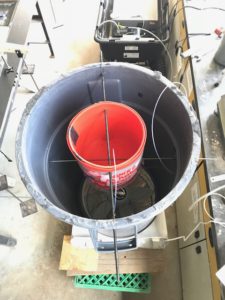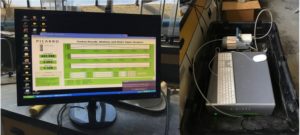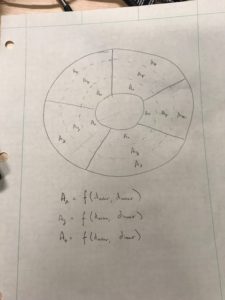I can’t believe I only have one week left here in Salt Lake City! While I will definitely not miss the heat, it will be hard to leave the work I am doing and all the amazing people I have met. This week ended up being insanely busy and I am sure that next week will be even more so.
On Monday we began by testing the breakers in the office to see what each of them controlled. This was mainly for Brian’s benefit as he is going to replace the lights in the office with LED track lights.
We then attached a box fan to our biggest size mock vent which is very similar to the size of the vent on the Student Union Roof. After assembling the vent, we hauled everything over to the GeoTech lab and ran a few experiments before we ran out of CO2. That afternoon, we created a list of all the things we have done thus far in the internship in preparation for a presentation we gave to the rest of the CSER group.
Tuesday we worked with Aaron on the presentation. We focused solely on the work we have done with the Arduino and Xbee network as well as the bench scale experiments we have done. After finalizing the PowerPoint, we configured another Xbee unit and set up another Arduino board just as we had with the others. This meant soldering parts onto the shield in order to allow the Xbee to communicate with the Arduino. The final Xbee unit allowed us to be able to stretch our network to the Student Union which was the ultimate goal.
We presented our work to the group on Wednesday including a demo of the live data transmission we have achieved through our Xbee units. Brian bought Indian food for lunch which was very generous and delicious. Brian also gave us a new project to complete before we leave–create a video summing up our work. We finished off the day by trying to get our new CO2 sensor to transmit data, however we did not have much luck.
Thursday a new CO2 tank came in, so we were able to resume our bench scale experiments. With the new set of experiments, we added in another element to enhance the analysis of the data. To do this we placed the LiCor machine, a spectrometer that has the ability to measure the concentration of CO2, next to the base of the vent to measure the level of ambient CO2 in the lab.
This allowed us to improve the data we collected as we could eliminate the ambient CO2 from the levels of CO2 the Picarro was reporting. This was critical because it showed that the ambient levels of CO2 were rising, not remaining static as we previously assumed, while we ran the experiments. Once again, we ran out of CO2, putting our experiments on hold.
Friday began with writing an equation that would allow us to find the area of an annulus that has been split so it has multiple radial positions (creating smaller annuli within the larger one) as well as multiple polar positions (where we took the measurements in regards to the circumference of the vent). We found this after some trial and error, but in the end, it worked well. Then, while Spencer worked on some Apple ShellScript coding, I worked on getting the CO2 sensor to read correctly. While I did get it to output values, the values are always either way too high (5000 ppm) or too low (0 ppm) for ambient CO2 levels (~400ppm). After running out of ideas for getting the sensor to read correctly, Spencer and I transitioned into working on our mock vent. Aaron discovered that the concentration of CO2 is consistently lower at the outer edge of the bucket and hypothesized that there is not enough turbidity causing the CO2 to thoroughly mix with the air before exiting the bucket. In an attempt to fix this, we place three pieces of duct tape across the bottom of the bucket to add disturbance to the air stream. We also lowered the CO2 diffuser in hopes that it will provide a little more time for the air to mix.
Friday night Valerie, Nayra and I went to the drive-in theater where we saw Mamma Mia 2. Saturday morning we went up to the Olympic Park in Park City and did an adventure course. We then walked around the museum that showed the history of Skiing in Park City and talked about the 2002 Olympics (which were held in Salt Lake City). Then we watched some skiers practicing at the Olympic practice center before walking around Main Street and heading back to Salt Lake.
Sadly, I only have one week left in Salt Lake City but I intend to make the most of it!




Wow Lexie, sounds like you’re coming up against some tough problems from optimizing the design of your mock test vent to getting the CO2 sensors up and running! Best of luck in your last week as you try to take those on as well as documenting all of your hard work! It’s been a wonderful journey following your blog as you demonstrate how quickly you’ve learned to navigate Arduino boards and obscure programming languages. You’ve developed quite an impressive background in geology, computer science, sensor networks, and experimentation. Not to mention the extensive help you’ve partitioned out to everyone in your lab. Impressive! Wishing you a successful and fulfilling last week!